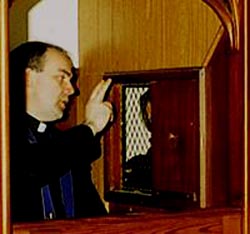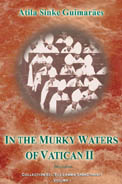 |
Consequences of Vatican II
Confession after Vatican II - Part II
Penance or Reconciliation?
Fr. Stephen F. Somerville, STL
In Part One of this series on sacramental Confession, we presented a brief “state of the question,” and reviewed some factors that may discourage people from using the Sacrament.
Let us focus now on its traditional name, Penance or Confession. The Sacrament is now being called “Reconciliation.” Is this remarkable change of name justified?
Reconciliation in the early Church
The word reconcile literally means to make good again, to win over to friendliness. It has a Church meaning also: to restore a penitent, an excommunicated person, to communion. God, having been offended by sin but now propitiated by the sinner’s repentance, and perhaps also by prayers of intercession, welcomes the sinner back to His grace and favor. The shining Gospel example of this reconciliation is surely the father receiving his returning prodigal and now repenting son in the famous parable (Lk 15).

The Parable of the Prodigal Son, by Rembrandt |
Did the Catholic Church at one time practice a public and more dramatic form of reconciliation for sinners? The answer is yes.
In its early stages, the Church was surrounded by hostile Jews and later by pagan Roman authorities who sensed a radical new enemy in the growing Christian Faith, which firmly refused to accept the customary Roman gods and the divinity of the Emperor. Amid such hostility, Catholics had need of bravery and strong conviction. Pope St. Peter put the fear of the Lord into the early Christians in his severe reproach to Ananias and Saphira for deceiving the Church and concealing part of the money they had promised to give. Nay more, God struck them both dead for their sin of deceit (Acts 5:1-11). Evidently, high standards of holiness were required if one became Catholic.
These early Christians also faced the risk of arrest, prison, torture and martyrdom from the Jews or Romans. Consequently, the early Catholic Church leaders threatened their members with severe penances and excommunication if they fell into one of the “big three” sins: murder, adultery, or apostasy (such as yielding to Paganism under threats, etc.). Such sinners would be moved into the category of paenitentes, obligated to a long period of fasting and penance, and granted only one chance of reconciliation. This reconciling was made only by the Bishop, usually at the Holy Thursday liturgy, with the whole Catholic community present.
Five reasons why not
This name “reconciliation,” is it what we now want to call the Sacrament of Penance? Let us start with a short answer: No, definitely not. And now, let us give the reasons why reconciliation should not be the name for the Sacrament of Penance.
First, the word “reconciliation” denotes only the final stage of the process of conversion. It does not express or convey the hard and humbling need for sorrow (contrition), for expiation, for atonement, for confession to a priest. Penance and Confession, conversely, do clearly express these more demanding stages of conversion.
Second, “reconciliation” is an act and a gift of God’s grace and of the Church’s favor, something outside the sinner’s action and doing. On the other hand, Penance and Confession express well the acts of the penitent. Reconciliation does not. Reconciliation is not done, but is received by the penitent.

A "reconciliation room" in a modern church lacks the sense of confession or penance. Below, a priest gives absolution in the traditional private confessional stand

|
Third, “reconciliation” is simply not applicable in a confession of devotion, that is, one without mortal sins. But the Church has always warmly encouraged confessions of devotion. In the encyclical Mystici Corporis, Pope Pius XII praised and encouraged the practice of frequent confessions:
"As you well know, Venerable Brethren, it is true that venial sins may be expiated in many ways, which are highly to be commended. But to ensure more rapid progress day by day in the path of virtue, We will that the pious practice of frequent confession, which was introduced into the Church by the inspiration of the Holy Ghost, should be earnestly advocated. By it genuine knowledge is increased, Christian humility grows, bad habits are corrected, spiritual neglect and tepidity are resisted, the conscience is purified, the will strengthened, a salutary self control is attained, and grace is increased by virtue of the Sacrament itself."
Pastors will tell you that most or many of the confessions made today are precisely those of devotion, without grave sin. These sinners had not lost the state of sanctifying grace. Reconciliation per se does not occur, because grace is not lost through venial sin. The use of the word “reconciliation” suggests to such sinners that they need not come. It will reduce the number of Confessions heard and the graces gained thereby. It will embarrass the remaining penitents, who could be seen as mortal sinners.
Fourth, young children can readily understand what confession and penance mean. They will hardly grasp a big, grown-up word such as “reconciliation.” It will tend to turn them away from the Sacrament, when the opposite attraction is called for. Speaking of grown-ups, we adults also are sensitive to changes of wording. Amid the multiple changes of the Church, of a cultural revolution, of the sense of sin dying around us, of psychobabble and bafflegab gone wild, this was a deplorable moment to bring in a new name to give to Confession.
Fifth, let us speak of absolution. This is the act of the authorized priest to absolve from sin. This word means to free a person from guilt, to release him from penalty, to remit a sin by the authority of the Church. It corresponds to Christ’s word on Easter night, remittere, Latin for to remit or to send away. It includes the somber possibility that the priest may have to hold back (retinere) the absolution if the sinner is not yet well disposed. As we see, remit is not quite the same as forgive. The priest is judge here, and the favorable decision to absolve means a real and objective freeing of this penitent from guilt, even if he is still feeling burdened with remorse or guilt feelings and still has expiation to offer, even if the offended person (not present) has not yet forgiven the sinner.
Are we to start calling this confession a “reconciliation”? Again, I think not. The word reconciliation could seem presumptuous or insensitive to the feelings of all concerned. Remember that when the Church did use that term in the early Church of the Fathers, the reconciliation ceremony was preceded by a long and severe penance. It was a major change for the Church eventually to assign only a light penance to and to grant absolution before the penance was performed. We do well to keep the name Confession.
In the next article of this series, we shall examine the changes made in the wording, or form, of the Sacrament of Penance. We will compare the old and new forms, side by side.

Posted February 5, 2007

Related Topics of Interest
 Confession Before and After Vatican II - Part I Confession Before and After Vatican II - Part I
 Desacrificing the Mass - Part I Desacrificing the Mass - Part I
 Desacrificing the Mass - Part II Desacrificing the Mass - Part II
 New Mass in Latin - Comments on Sacramentum caritatis New Mass in Latin - Comments on Sacramentum caritatis
 Crisis in Catechism Crisis in Catechism
 The Bugnini Liturgy and the Reform of the Reform The Bugnini Liturgy and the Reform of the Reform
 The Catholic Revolution: New Wine, Old Wineskins and Vatican II The Catholic Revolution: New Wine, Old Wineskins and Vatican II
 Is the Catholic Crisis Really Explained? Is the Catholic Crisis Really Explained?
 The Canonization of Wojtyla - the Moral Free Pope The Canonization of Wojtyla - the Moral Free Pope
 Resisting the Novelties of the Conciliar Church Resisting the Novelties of the Conciliar Church



|
Vatican II | Hot Topics | Home | Books | CDs | Search | Contact Us | Donate

© 2002-
Tradition in Action, Inc. All Rights Reserved
|
 |
|